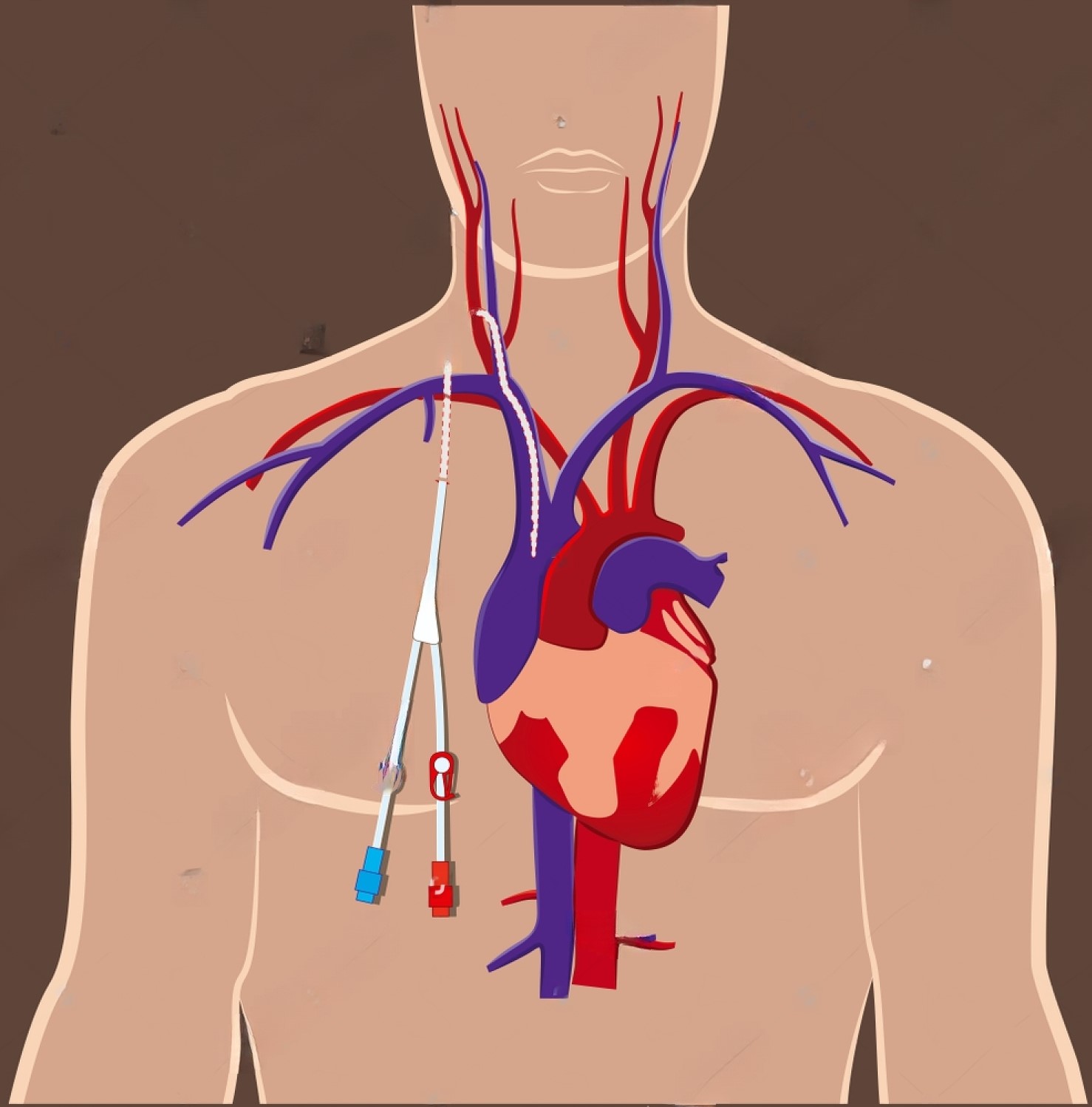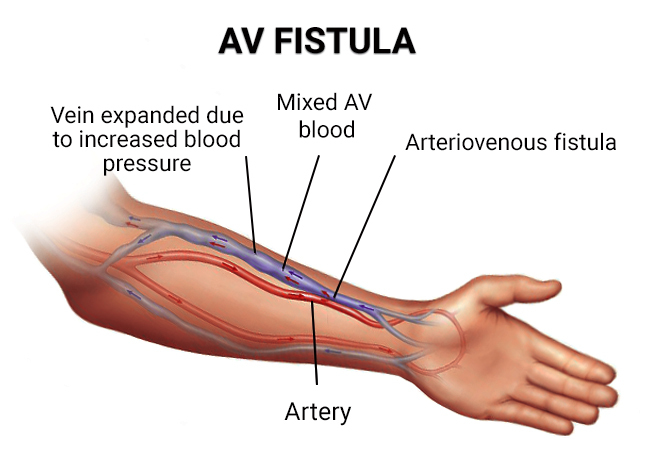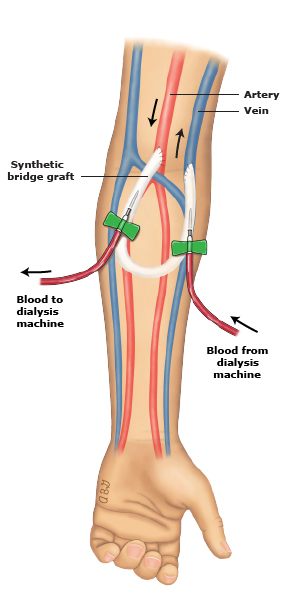4 Types of Dialysis Access
There are three different types of dialysis access used for hemodialysis, a process in which blood is transported from your body for cleaning.
- Central venous catheter (CVC)
- Arteriovenous fistula (AV Fistula)
- Arteriovenous graft (AV Graft)
Another type of dialysis, called peritoneal dialysis, which uses the abdominal lining and a specialized sterile solution to clean the blood inside your body, requires a different type of access known as:
- Peritoneal dialysis catheter (PD Catheter)
Which access is the best for you will depend on many factors. Let’s look at each type of dialysis access separately.
Central Venous Catheter (CVC)
The first type of access we’ll look at is a central venous catheter (CVC), which is a flexible, long, plastic, y-shaped tube that is threaded through your skin into a central vein in your neck, chest or groin. A CVC is not usually intended to be a permanent type of access. If you need immediate or emergency dialysis or cannot receive and don’t have an AV fistula or graft, you will require a CVC.
Caring for Your CVC
If you have a CVC placed, you’ll need to learn to care for your catheter regardless of whether it’s permanent or temporary. Your physician will give you strict care instructions, so be sure to follow them.

Before having a CVC placed, you should understand both the advantages and disadvantages of this access option.
Advantages
- Quick to place and remove
- May be used immediately for dialysis
- Central Venous Catheter Placement is an outpatient procedure
Disadvantages
- May damage central veins
- May increase the length of the hemodialysis treatment
- Bathing and swimming not recommended
- Complications can include infection and catheter clotting
AV Fistula
The second type of dialysis access is an AV fistula, which is an actual surgical connection made between an artery and a vein. An AV fistula is most often created in your non-dominate arm, but sometimes it can be created in your leg. This access results in an increased blood flow rate through the vein, which helps enlarge and strengthen the vein. An AV fistula allows a higher rate of blood to flow back and forth from your vein to a dialysis machine.
An AV fistula is the preferred access of all the types of hemodialysis access and is often referred to as the “gold standard.” In 2013, 65% of all patients in the United States Renal Data system were exclusively using an AV fistula at the end of one year of dialysis.
Once the AV fistula creation is complete, you will need to wait several months before it can be used so it can fully heal and mature.

Caring for Your AV Fistula
Once you have an AV fistula, you’ll need to take care of it. Every day you’ll need to pay careful attention to your AV fistula to ensure it’s functioning properly.
- Look – Check for signs of infection, such as swelling, redness, warmth and drainage, as well as bleeding, peeling of the skin over the access or bulging areas.
- Listen – Check for the sound of blood flowing through your AV fistula by putting your ear over your access site.
- Feel – Check for vibration, called the “thrill.” The absence of or change in thrill could be cause for concern.
While an AV fistula is generally considered the best access option, it also has some disadvantages. Let’s look at both the advantages and disadvantages.
Advantages
- Can function for years
- Not as likely as a catheter to become infected
- Not as likely to clot
Disadvantages
- May require another temporary type of access during the healing and maturation phase
- Maturation may be delayed, or it may fail to mature
- Needles are required to access the AV fistula for hemodialysis
AV Graft
The third type of access, called an AV graft, functions similarly to an AV fistula. If you have blocked or damaged veins, or veins that are too small for a fistula, you may be a candidate for an AV graft. AV graft placement is also a surgical procedure, but instead of connecting the artery directly to the vein, one end of a small hollow, synthetic tube will be connected to your vein, and the other end will be connected to your artery.

Caring for Your AV Graft
Just like with an AV fistula, you will need to care for your graft every day, so remember to look, listen and feel for the same indicators used with a fistula.
As with all types of dialysis access, an AV graft also has advantages and disadvantages.
Advantages
- Ready for use in days to 3 to 4 weeks
- Easy to implant
- Placement is an outpatient procedure
Disadvantages
- Doesn’t last as long as an AV fistula
- Needles still required to access the graft
- Prone to clotting
PD Catheter
A PD catheter is used for peritoneal dialysis, which uses the lining of your belly and a dialysate solution to clean your blood.
This type of dialysis can be a desirable method for people who are always on the go. With a PD catheter, dialysis can be performed at home and takes less time to accomplish.
If you are unable to care for yourself, have an abdominal hernia or inflammatory bowel disease, recurring diverticulitis or large surgical scars on your belly, peritoneal dialysis and the PD catheter may not be an option for you.ii
Caring for Your PD Catheter
Having a PD catheter is associated with a high risk of infection in the lining of your belly, the tunnel that the catheter is threaded through or in the site where the catheter exits your body.iii
As your catheter site heals, and when you are accessing the catheter for your prescribed peritoneal dialysis exchanges (or treatment), you’ll need to follow a strict sterile protocol.

Let’s look at the advantages and disadvantages of a PD catheter.
Disadvantages
Advantages
- PD Catheter Placement is usually performed as an outpatient procedure
- No need to use needles
- Dialysis performed at home
- No need for a temporary CVC
- Bathing and swimming not recommended
- Higher risk of clotting and infection
Getting to the point where you have to seriously consider dialysis can be a scary time. But being prepared and understanding all types of dialysis access means you can feel confident in the choice you and your doctor make. Be sure to carefully consider each of the various types of dialysis access and discuss which will offer you the best quality of life.


